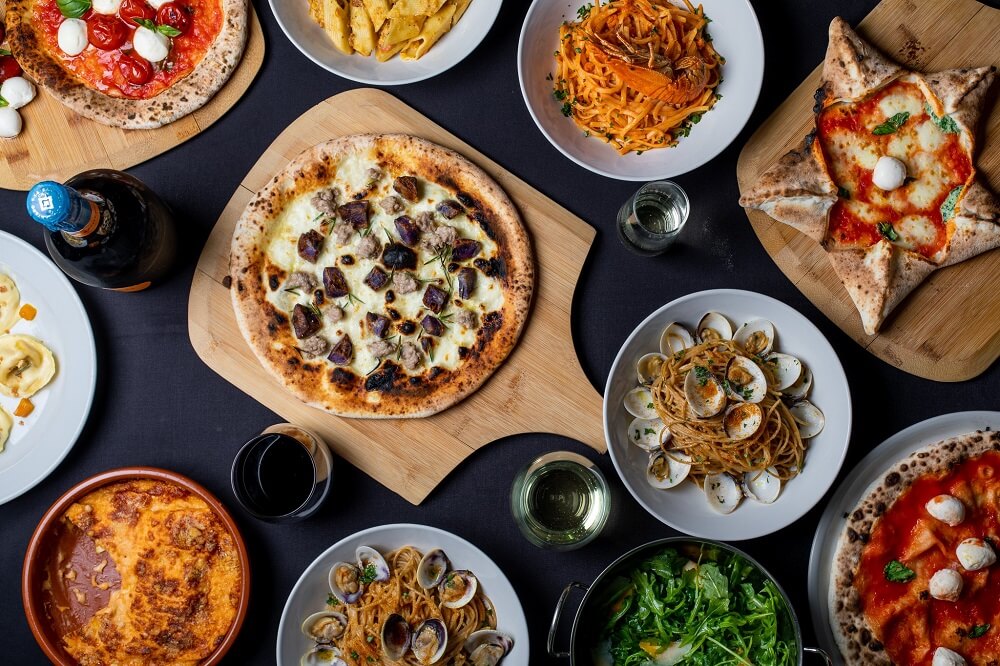Introduction to Italian cuisine
Step into the tantalizing world of Italian cuisine, where every bite tells a story of tradition, passion, and flavor. From the rolling hills of Tuscany to the bustling streets of Naples, Italy’s culinary heritage is as diverse as it is delicious. Get ready to embark on a gastronomic journey like no other with joyciano – your gateway to authentic and mouthwatering Italian dishes that will transport you straight to the heart of Italy. Let’s dive in!
The history and origins of Italian food
Italian cuisine is a rich tapestry woven with centuries of history and influences from various civilizations. The roots of Italian food date back to the Roman Empire, where ingredients like olive oil, garlic, and herbs were staples in their diets.
Over time, Italy’s culinary traditions evolved with the introduction of new ingredients brought by traders and explorers. The Renaissance period saw a flourishing of Italian gastronomy, as chefs experimented with different flavors and techniques.
Each region in Italy boasts its own unique specialties based on local produce and customs. From creamy risotto in the north to fiery pasta dishes in the south, every bite tells a story of tradition and heritage.
Italian food has become synonymous with fresh ingredients such as tomatoes, basil, mozzarella cheese, and balsamic vinegar – simple yet bursting with flavor.
The fusion of historical influences has created a vibrant culinary landscape that continues to captivate food enthusiasts worldwide.
Regional specialties and their cultural significance
When it comes to Italian cuisine, each region boasts its own unique specialties that reflect the local culture and traditions. From the rich risottos of Lombardy to the hearty pasta dishes of Emilia-Romagna, every bite tells a story of centuries-old culinary heritage.
In Sicily, you’ll find flavors influenced by Arab and Spanish invasions, resulting in dishes like arancini and caponata that are bursting with vibrant Mediterranean ingredients. Moving north to Tuscany, simplicity reigns supreme with rustic soups like ribollita and iconic meats such as bistecca alla fiorentina showcasing the region’s focus on high-quality produce.
Veneto is famous for its seafood-centric cuisine, with classics like risotto al nero di seppia highlighting the Venetians’ close relationship with the sea. And let’s not forget about Naples and its world-renowned pizza Margherita – a true symbol of Italian gastronomy adored globally.
Each regional specialty is a testament to Italy’s diverse landscape and history, making every dish a delicious journey through time.
Essential ingredients in Italian cooking
When it comes to Italian cooking, the ingredients are the heart and soul of every dish. Olive oil, a staple in Italian cuisine, is used for everything from sautéing vegetables to dressing salads. The quality of olive oil can truly elevate a dish to another level.
Tomatoes play a crucial role in many traditional Italian recipes, whether they’re fresh or canned for sauces like marinara or pomodoro. Fresh basil adds a burst of flavor and freshness to pasta dishes and pizzas alike.
Parmigiano Reggiano, known as the “king of cheeses,” is often grated over pasta dishes or risottos for its rich and nutty taste. And let’s not forget about garlic – an essential ingredient that brings depth and aroma to countless Italian recipes.
From creamy risottos enriched with butter and Parmesan cheese to hearty ragù simmered slowly with tomatoes and herbs, each ingredient contributes its own unique flavor profile to create the delicious tapestry that is Italian cuisine.
Traditional cooking techniques and methods
Italian cuisine is renowned for its traditional cooking techniques and methods that have been passed down through generations. One of the fundamental principles in Italian cooking is the use of fresh, high-quality ingredients to create flavorful dishes. From homemade pasta to slow-cooked sauces, Italians take pride in their culinary traditions.
In Italy, simplicity is key when it comes to preparing food. Many recipes only call for a handful of ingredients but rely on careful preparation and precise cooking techniques to enhance flavors. For example, bruschetta with ripe tomatoes, garlic, basil, and olive oil showcases the essence of Italian cuisine without being overly complex.
Another hallmark of Italian cooking is the art of risotto-making. This creamy rice dish requires patience and attention as you slowly add warm broth while stirring constantly until achieving a luscious texture. The result is a comforting meal that embodies the heartiness and warmth of Italian hospitality.
Popular Italian dishes and their recipes
Italian cuisine is a treasure trove of beloved dishes that have captivated taste buds worldwide. One iconic dish is the classic Spaghetti Carbonara, where al dente spaghetti is tossed with crispy pancetta, eggs, Pecorino Romano cheese, and black pepper.
Another favorite is the hearty Lasagna alla Bolognese, comprised of layers of pasta sheets filled with a rich meat sauce, creamy bechamel, and melted mozzarella. If you’re craving something comforting yet elegant, try making Osso Buco – braised veal shanks in a flavorful broth served with gremolata on top.
For seafood lovers, Linguine alle Vongole will transport you to the coast of Italy with its delicate mix of linguine pasta and fresh clams cooked in white wine and garlic. And let’s not forget about Tiramisu: layers of coffee-soaked ladyfingers and mascarpone cream sprinkled with cocoa – a dessert fit for royalty!
Tips for creating an authentic Italian dining experience at home
To create an authentic Italian dining experience at home, start by selecting high-quality ingredients. Look for fresh produce, artisanal cheeses, and imported olive oil to elevate your dishes. Embrace simplicity in your recipes – let the flavors of the ingredients shine through without overpowering them with too many seasonings.
Consider the presentation of your meal; Italians take great pride in how their food looks on the plate. Use colorful vegetables and fresh herbs to add visual appeal. Set a welcoming table with rustic plates and linen napkins to set the mood for a cozy dinner.
Pair your meal with a good bottle of Italian wine or make a refreshing spritz cocktail to accompany your dishes. And don’t forget about dessert – indulge in classic treats like tiramisu or panna cotta to end on a sweet note.
Put on some traditional Italian music in the background, light candles, and enjoy leisurely conversation around the table with friends or family. Buon appetito!
Dining etiquette and customs in Italy
When dining in Italy, it’s essential to understand the cultural nuances that come with enjoying a meal. Italians take their food seriously, and dining is seen as a time for connection and enjoyment rather than just sustenance.
One key aspect of Italian dining etiquette is the pace of the meal. Meals are meant to be savored slowly, allowing time for conversation and appreciation of each dish. Rushing through a meal is considered impolite.
Another important custom is respecting the order of courses. In Italy, meals typically consist of multiple courses starting with antipasti, followed by primo (first course), secondo (second course), contorno (side dish), and dolce (dessert).
Italians also have specific rules about coffee consumption – ordering cappuccino after 11 am or having it with a meal is not common practice. Instead, opt for an espresso to end your meal like a true local.
Remembering these customs will not only enhance your dining experience but also show respect for Italian traditions.
Current trends and innovations in the world of Italian cuisine
Italian cuisine is constantly evolving with new trends and innovations making their way into the culinary scene. One of the current trends in Italian cooking is a focus on sustainability and locally sourced ingredients. Chefs are increasingly turning to organic produce and supporting small-scale farmers to create dishes that not only taste delicious but also have a lower environmental impact.
Another innovation gaining popularity is the fusion of traditional Italian recipes with modern techniques, creating unique flavor combinations and presentations. This blending of old-world charm with contemporary flair adds a fresh twist to classic dishes while still honoring Italy’s rich gastronomic heritage.
Moreover, there has been a resurgence of interest in ancient grains like farro, spelt, and kamut, as Italians rediscover these nutritious alternatives to conventional wheat. These grains bring depth of flavor and texture to pasta dishes, breads, and desserts.
In addition, plant-based Italian cuisine is becoming more prevalent as people embrace vegetarianism and veganism for health or ethical reasons. Chefs are experimenting with inventive ways to showcase vegetables as star ingredients in traditional Italian recipes without compromising on taste or authenticity.
Conclusion: Why joyciano is a must-try for food lovers
Italian cuisine is a celebration of flavors, traditions, and history. From the humble beginnings of rustic dishes to the refined delicacies enjoyed today, Italian food has captivated taste buds around the world. joyciano embodies this rich culinary heritage with its commitment to authenticity and quality.
For food lovers seeking an unforgettable dining experience, joyciano is a must-try destination. Whether you’re savoring traditional pasta dishes or indulging in innovative creations, each bite tells a story of passion and craftsmanship. So gather your loved ones, raise a toast with a glass of fine Italian wine, and let joyciano transport you to the heart of Italy through its delectable offerings. Buon appetito!










